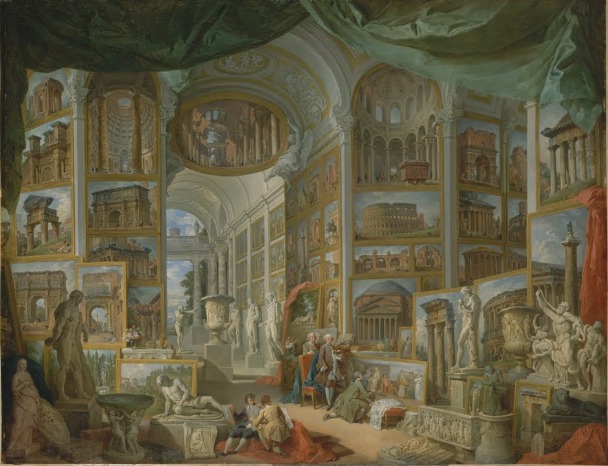Views of Ancient Rome
While Canaletto painted cityscapes, scenic trade routes, and the activity of urban life, Panini, like his contemporary, Piranesi (1720-1778), spent much of his time painting the ruins of Rome. Often, these images were romanticized and featured imagined landscapes; yet, the architectural subjects of the images were nearly always identifiable. Thus, his depictions of Rome in ruins were marked with a degree of nostalgia that coincided with the concurrent fixation among European elites for Greco-Roman antiquity.
Serving as a catalogue of collectibles and a guidebook for the Grand Tour, Panini’s oil painting entitled Ancient Rome encapsulates the high value that the public imposed upon classical antiquities during the seventeenth and eighteenth centuries. It was created for the Duc de Choiseul (1719-1785), who is depicted in the center of the 172.1 x 229.9 cm composition holding a guidebook—presumably, one that might direct a traveler on the Grand Tour to the sites and works of art presented to the viewer in the painting.[1] -The invented scene, or capriccio, illustrates an interior view of an architectural space that is replete with classical objects. A green cloth is propped to the upper-right side of the picture plane—much like a curtain on a stage-- so that the viewer may gaze upon the majestic, imaginary collection. Considering his background in architectural design, it is no surprise that Panini utilized a great amount of detail in formulating a characteristically classical interior furnished with Corinthian columns, coffered domes, and a vault that draws the viewer's eye into the painting. Lining the walls of the building’s interior is an assemblage of paintings detailing identifiable buildings from the ancient world. From the Temple of Romulus and the forum of Nervac to the Baths of Diocletian and the Arch of Septimium Severus, Panini demonstrates his skill as a draftsman while emphasizing the magnificent architectural wonders that may be seen while in Rome on the Grand Tour.[2] Furthermore, he renders familiar antiquarian objects of Greco-Roman tradition including the sculpture of Laocoön and his sons, the base of the Column of Antoninus Pius, and the Nozze Sarcophagus.[3]
Indeed, Panini’s fantastical collection is nearly exhaustive in its completeness, exhibiting the most well-known classical buildings and antiquarian objects. While bolstering his patron’s status as a scholarly aristocrat who involved himself in collecting and intellectual activities, Panini simultaneously reinforced Rome as a destination for artists, intellectuals, and noblemen alike. The painting currently resides in the Metropolitan Museum of Art’s permanent collection alongside its counterpart, Modern Rome, which will be discussed later.[4]
[1] "Ancient Rome | Giovanni Paolo Panini | 52.63.1 | Work of Art | Heilbrunn Timeline of Art History | The Metropolitan Museum of Art," MET, accessed March 28, 2017, http://www.metmuseum.org/toah/works-of-art/52.63.1/.
[2] Massimiliano David and Filippo Coarelli, Ruins of Ancient Rome: the drawings of French architects who won the Prix de Rome, 1786-1924 (Los Angeles: The J. Paul Getty museum, 2002).
[3] Ibid.
[4] Wendy Wassying Roworth, "Art in Rome in the eighteenth century (Book Review)," Art Bulletin 83, no. 1 (2001): 135-144.
